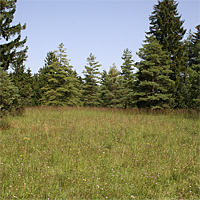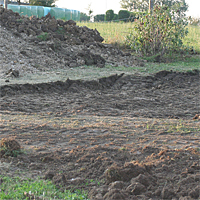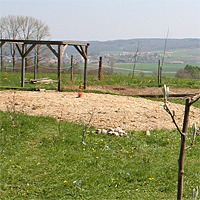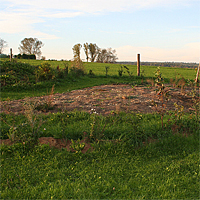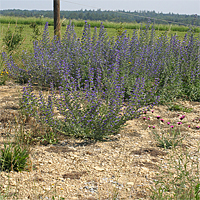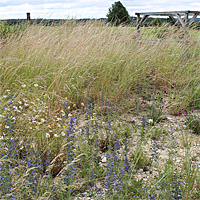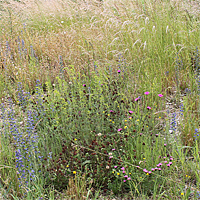Lech heath
Overview
Along the Lech between Schongau and Augsburg are numerous semi-dry to dry grasslands on a base of partly several metres measuring layers of river gravels with a thin loess covering layer located. These neglected grasslands are called Lech heaths and are very species-rich biotops, inter alia with the occurence of numerous orchid and gentian species.
The development of the Lech heaths dates back 120.000 years, then the Lech glacier has pushed enormous gravel amounts forward as far as Augsburg during glacial periods. Later these gravel amounts have been partly removed by the Lech in one place, partly have been piled up in another place. Afterwards continuing tundra winds have deposited a loess layer. Due to subsequent grazing caused by human have evolved hereupon great, warm, dry and nutrient-poor heath areas, which current occupy only 1% of the original area.
Almost all today’s Lech heaths are protected and harbour an unique flora and fauna, these include also 28 orchid species which are to be found on the heath areas and within the surrounding alluvial forests. Thereunder is also be found the critically endangered Bug Orchid (Orchis coriophora).
Smaller heath areas on gravel layer within alluvial forest are called Lech heaths. They are characterized by an unique microclimate. Due to surrounding forest takes barely an air exchange place in summer, so that the areas can heat up to 50°C.
Project
Explanation of construction and schematic depiction
 I began also with the construction of the Lech heath in late summer 2009. At first soil was 20 cm deep bulldozed away and a relief-rich underground created.
I began also with the construction of the Lech heath in late summer 2009. At first soil was 20 cm deep bulldozed away and a relief-rich underground created.
I filled this area witha circa 20 – 40 centimeters high gravel layer (grain size 12 – 25 mm) in the following spring. On the top, I brought a 2 centimetres high clay layer up. All around the area I planted a natural hedge, consisting of several native bushes.
Progress
At first, the area appeared as distint dry grassland, among others supported by low rainfalls in spring. Even after extensive rainfalls the area was completely dried after two or three days, so that almost no plants germed. Therefore I covered the area with some lawn clippings in late summer to reduce evaporation. After these measures growth showed a substantial progress. Now it is primary aim to establish on the area a stable growth with moor grass. Afterwards I will try to settle the one or other character plant of Lech heaths.

